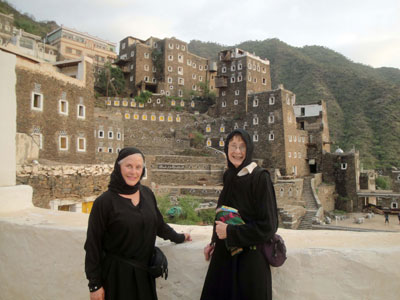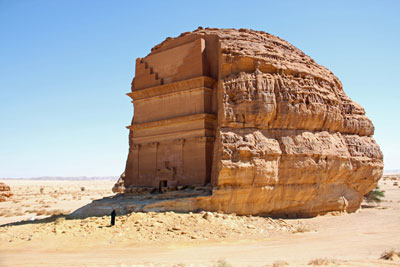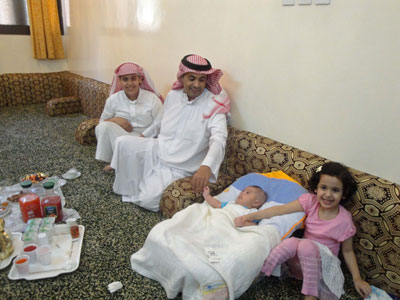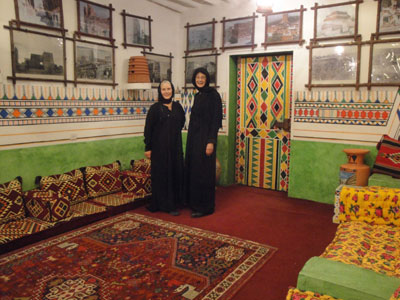Sights of Saudi Arabia
This item appears on page 12 of the April 2013 issue.
When it was determined that my friend Patti and I were the only two people signed up for a Nov. 4-18, 2012, tour of Saudi Arabia with Spiekermann Travel (Eastpointe, MI; 800/645-3233), we were given the option of going without the usual tour leader who was a college professor but with a private guide. We accepted, and our guide, Khaled M. Al Took, was probably the best in the country. The all-inclusive land price for each of us was about $7,000.
So there were just three of us, with Khaled driving. I think I might have learned more on this trip than on any other 2- week tour I have been on, probably because I knew so little about Saudi Arabia beforehand.
Saudi Arabia was never colonized. It is a more or less uniform society of Muslims, mostly Wahhabi, a strict branch of Sunni Islam. The women are not allowed to drive. There are no movie theaters (but they get all the DVDs and watch them in their homes).
Khaled bought each of us an abaya, basically a lovely black dress with beaded trim, and we wore that over our clothes for the two weeks. We were even able to climb up a mountain in that garb to see rock art. Head scarves were not mandatory in Jeddah, but we wore them everywhere else. Most of the local women were in black abayas and had their faces covered as well.
Our meals varied from fancy hotel buffets to our dining sitting on the floor eating with our hands from the communal plate. (They gave Patti and me plastic spoons.) The eating establishments, including McDonald’s, had room dividers or curtains separating tables and booths so the ladies could have their privacy from the men.
Jeddah was interesting, as there were many busloads of tourists from Burma, Indonesia, the Philippines, India, etc., who had just finished the hadj (pilgrimage to Mecca) and were touring the rest of the country. They were dressed in Muslim garb but with color-coded scarves (one busload with orange, another with blue, etc.).
I knew that Patti and I would never get to see the religious sites of Makkah (Mecca) and Madinah (Medina), which millions of Muslims visit each year, but I had no idea there were so many other things to see in Saudi Arabia.
After looking around Jeddah and having a great meal at the fish market, we flew to Abha in the south, near Yemen. We were in the mountains there and saw tall houses similar to those of Yemen, some with museums. We rode a cable car to see the ruins of a village set into the cleft of a canyon wall and also looked around Najran.
We then went east to the fringe of the Empty Quarter, which, according to our Lonely Planet guidebook, is the largest area covered by sand on the planet, an area larger than France. We visited ruins of old trading centers and saw prehistoric carvings on rocks in the mountains.
We flew back to Jeddah and, because of an airline schedule change, drove the long way to Al-`Ula. The roads were great, gas cost only 12 cents a liter and we got to see the scenery.
Al-`Ula was our headquarters for visiting Madain Saleh (a Nabataean site, like Petra in Jordan) and the former Hejaz Railway Station (depicted in the film “Lawrence of Arabia”). We didn’t photograph all hundred-plus tombs at Madain Saleh, but we tried!
There were also older ruins, palaces, Ottoman forts and lots more rock carvings. Our guidebook said there are about 2,000 rock art sites in Saudi, but Khaled said it’s more like 10,000.
In between these sites it wasn’t all bare desert. There were lots of date plantations and oil-producing areas. When we got to the camel market in Riyadh, we overdosed on cute camel photo ops.
One highlight of Riyadh was an upscale shopping mall where on the second floor no men were allowed and the women could take off their head coverings and socialize. On the lower floors, it was fun to look at the fancy designer abayas being worn. Think over-the-top gold trim and beads, etc.
We visited a German man and his wife in Riyadh. He has worked in Saudi Arabia for more than 20 years, and she has an amazing collection of fossils, rocks, minerals and artifacts from the desert. Hearing about their life there was fascinating.
Khaled is a great ambassador for his country. He knows that it will change but hopes it will be in a way suitable for his culture.
I had a great time in Saudi Arabia.
DORIS NEILSON
Hanover, PA




